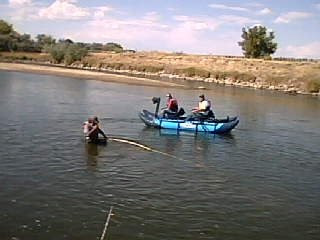Protecting land and water near Casper, Wyoming
In 2008, MATCOR was asked to evaluate a sheet pile barrier wall separating a former refinery from the North Platte River, near Casper, which was designed to protect the river from spoils of the refining process. The North Platte River is one of the Western United States’ great rivers and offers some of the finest fly fishing on the planet. Since 1996, Trihydro Corporation has handled engineering and environmental consulting for the refinery, focusing on recovery of free phase hydrocarbons, removal of source materials and protection of the river. Protecting the sheet pile barrier wall from corrosion was a mission-critical task. Both the water side and the earth side of the wall offered different challenges, so unique cathodic protection systems were designed for each side of the 3400 foot long wall.

On the water side, MATCOR’s SPL ™- HDP
 Anode was utilized; on the earth side, SPL™-FBR was the best option. Like every project, customized engineering plans were drafted, and carefully selected anodes manufactured specifically for the job at MATCOR’s Pennsylvania headquarters. The presence of bedrock from 10 to 40 feet below the surface, the amount of current required for CP, and the physical properties and limitations of the site were influencing factors in the choice of cathodic protection materials.
Anode was utilized; on the earth side, SPL™-FBR was the best option. Like every project, customized engineering plans were drafted, and carefully selected anodes manufactured specifically for the job at MATCOR’s Pennsylvania headquarters. The presence of bedrock from 10 to 40 feet below the surface, the amount of current required for CP, and the physical properties and limitations of the site were influencing factors in the choice of cathodic protection materials.Installation and commissioning had to take place in September and October 2008, when the North Platte was at its lowest.
When planning schedules for CP installation, MATCOR has worked around snow and frozen tundra, rainy seasons, tidal changes, and space flight launch schedules, but this is the first time we’ve designed our system and timeline around the rise and fall of a river. Right now Casper, Wyoming is cold and snowy, but the CP system is at work, protecting the sheet pile wall, and in turn, the environment of one of America’s beautiful places.


